50 years of heart transplants
On December 3, 1967, fifty years ago, a successful heart transplant was first performed in South Africa. The heart of a 25-year-old Denise Darwal who died in a car accident was transplanted to 55-year-old Luis Vashkansky. He lived only 18 days, but died not because of the body's rejection of the heart or the failure of a new organ, but from bilateral pneumonia. The second patient of the same cardiac surgeon lived more than one and a half years, the third - more than twenty.
Fifty years of heart transplantation surgery is not considered fantastic. Let's remember how people get a second chance for life.

Surgeon monitors patient's vital signs after a 23-hour heart transplant operation
By the beginning of the 20th century, the first successful organ transplant operations, including man, had already been carried out in the world. In 1905, in the Czech Republic, doctor Edward Cirm used the cornea in both eyes of an 11-year-old child to transplant a 45-year-old man. As a result, one eye could not be saved, and the second continued to see for 12 years until the patient died. The cornea has no blood vessels, most often survives, but in this case the most important is the issue of preserving the donor material.
This problem was solved by the Russian ophthalmologist Vladimir Filatov : he began to transplant corneas of corpses, and kept the material for the operation for 1-2 days after the death of the donor at a temperature of 2-4 degrees above zero in a humid chamber. The first successful operation of this kind took place in 1931. In addition, Filatov, together with designer A. Martsinkovsky, developed tools that were less dangerous for the lens and increased the efficiency of the operation.
"Odessa is my only lighthouse,
There are fights with a mat and without a mat,
And if you get an eye out in Odessa
Then this eye will give you Filatov. ”
Odessa lights the lights, E. Agranovich
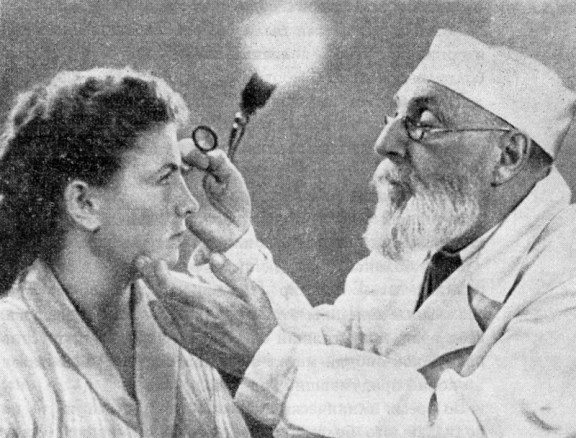
Ophthalmologist Vladimir Filatov at work
The next important step in transplantation was kidney transplantation. In Russia, Yevgeny Chernyakhovsky experimented in this direction. In 1903-1904, this surgeon performed 554 surgeries on the abdominal organs, heart and blood vessels. Since 1907, he experimented with kidney transplantation on animals, which he told in 1913: “We succeeded in kidney transplant experiments, the vascular permeability was restored, but then the kidney gangrenisciation”. In the 1920s, he continued to experiment with his student Yuri Voronim .
In 1930, at the Third All-Union Congress of Physiologists, Yuriy Voronoi presented a dog with a kidney transplanted to its neck, which had been functioning by that time for more than six months. In 1933, Voronoi performed the world's first kidney transplant to a person from a deceased donor. Although donor and recipient blood groups did not match, the surgeon took a risk. The organ was transplanted to the thigh and it began to function. The patient lived for two days. An important discovery of Yuri Voronoi was the very possibility of using the cadaver kidney, an organ taken several hours after the death of a person. He established that such a kidney “comes to life” after transplantation and can function, as he wrote in the Italian scientific journal “Vіnerv hіrurgіsa” in 1934.
Yuriy Voronoi denied the possibility of using a kidney, an important organ, from a living person: "It is impossible to inflict deliberate disability on a healthy person, cutting out from him the organ needed for transplantation for the problematic rescue of the patient." But today, such operations are carried out, and the first successful was the second kidney transplant of a twin brother on December 23, 1954. Richard Herrick with a body that used to work in the body of his twin brother Ronald lived for nine years, married a nurse who looked after him during the Christmas holidays, and became the father of two daughters. In 1990, doctor Joseph Murray , who carried out this operation, received the Nobel Prize.
Immunobiological factors remained an important issue, organs could be rejected by recipients. In the case of the twin brothers, immunosuppression was not required, but this was an exception to the rule. In 1959, after a transplant from a post-mortem donor who was not a relative of the patient, body irradiation was used to suppress immunity - the result was 27 years of life after a kidney transplant operation.
Our immune system protects the body from foreign cells, which can be either an infection or a foreign organ. The development of immunosuppressants has opened a new era of transplantology. Patients take medications to avoid rejection. The side effect of these drugs is obvious: weakening of the immune system reduces the body's ability to resist infections.
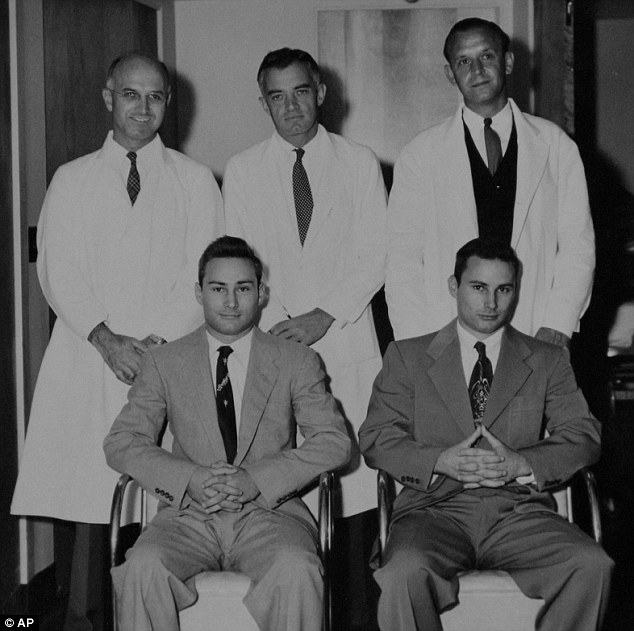
Brothers Richard and Ronald Herrick
One of the founders of transplantology is considered by the Soviet and Russian scientist Vladimir Demikhov . He conducted many experiments that influenced medical science. In 1937, a dog with a mechanical device in the form of a pump with an electric motor instead of a heart lived for two and a half hours.
Vladimir Demikhov transplanted lungs, heart, liver to dogs, proving the principal possibility of such operations. In 1946, he transplanted a second heart to the dog, and later completely replaced the heart and lungs. In 1954, he introduced a two-headed dog - transplanted his head with a neck and front paws of a puppy to an adult shepherd dog. He repeated this experiment twenty times, a record in which was the month of life of such a creature. His 1960 book, Transplant of Vital Organs in an Experiment, was the first monograph on transplantology in the world.

Vladimir Demikhov and a dog with two hearts
In the 1960s, a race began between several surgeons. American surgeon Norman Shamway from the Stanford Clinic successfully performed heart transplants for dogs, some of which lived up to one and a half years. He created a method by which heart transplantation is performed today: he did not remove the heart completely, but left the upper part of the atrium together with the large veins, which significantly reduced the time spent on the operation and its complexity. Norman waited for the opportunity to perform an operation on a man. - he needed donors.
Norman Shamway was ahead of Christian Barnard , an old friend of the University of Minnesota. Barnard used the insights of Vladimir Demikhov, Norman Shamway and Richard Lower . The surgeon studied in the United States, and in 1960 and 1963 he came to the USSR to Vladimir Demihov.
The recipient was 55-year-old Louis Vashkansky, who was admitted to the hospital in Groot-Shur, South Africa after three heart attacks. He agreed to the operation, since in any case he had a few weeks left to live. There were problems with the donor: the political regime of South Africa did not allow the use of the heart of blacks. Previously, because of this, there was a scandal involving Barnard himself - he transplanted a black citizen’s kidney to a white man. He was accused of experimenting with blacks. The same people with Louis of the Washkan race were only 20% of the population. Even less - with the right blood type. An accident on the road, in which a 25-year-old employee of the bank Deniz Darwal died, gave Washkan a chance to survive.
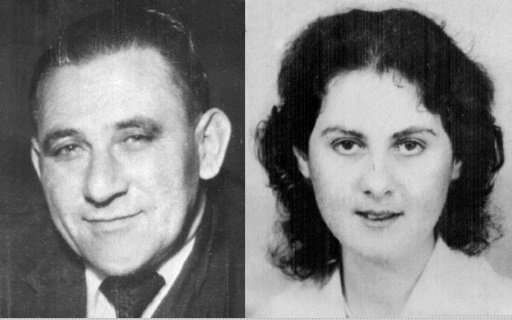
Louis Vashkansky and Deniz Darwal
Denise’s father agreed to the operation: “If you cannot save my daughter, you must try to save this man.”
The operation took place on December 3, 1967 and lasted about five hours. In the process, it was noted that the heart of the girl is much smaller than the heart of the recipient, but it still began to function. A few days later, Louis Vashkansky was able to get out of bed, he ate, smiled, and journalists constantly came to him. He lived for 18 days, after which he died of pneumonia, enhanced by suppression of the immune system to prevent organ rejection.
The next operation was more successful - Philip Bleiberg lived more than one and a half years. Dirk van Zyl after the operation in 1971 lived for 24 years. By December 1968, a year after the first operation, about 100 heart transplants were performed worldwide.

Cover of Life, December 1967: Christian Bernard and his patient Louis Vashkansky with the heart of 25-year-old Denise Darwal
In the USSR, the first heart transplant was performed much later, in 1987. In the USSR there were no donor centers. All twenty years after the operation in South Africa, Valery Shumakov, together with his colleagues, tried to prove that brain death is human death, and that in that case it should be a sufficient basis for organ removal to save other lives. In 1987, common sense triumphed, and the death of the brain began to be accepted for death in the USSR.
On March 12, 1987, the twenty-five-year-old Alexandra Shalkova with cardiomyopathy became the first patient in the USSR to undergo a heart transplant. The girl lived more than eight years. “I think she could live today. But Shura once did not take the prescribed pill on time to suppress the rejection reaction. She was ruined by ordinary negligence. This, unfortunately, happens. Not every human body can receive an implanted organ, ” said Valery Shumakov.
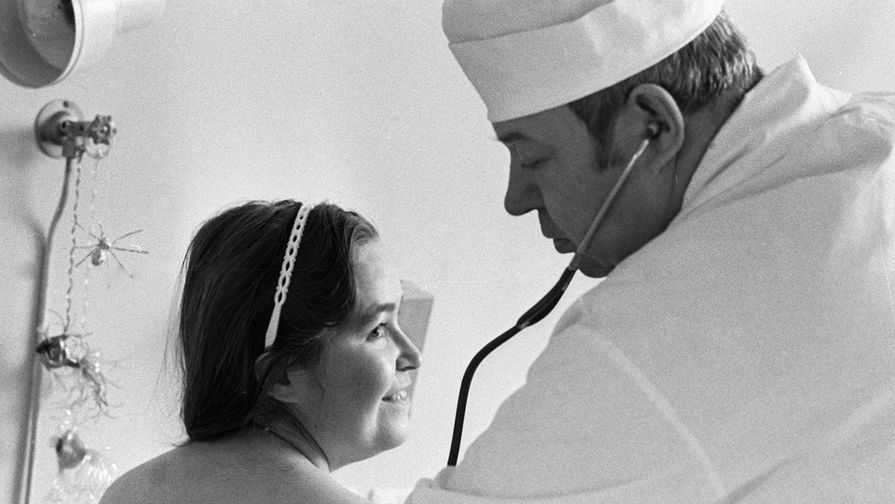
Surgeon Valery Shumakov and patient Alexandra Shalkova, examination after heart transplantation
Vladimir Patokin, who received a second heart in February 1992, became one of the most famous patients of the Institute of Transplantology and Artificial Organs named after Shumakov. At that time, Patokin was 40 years old, and in 2012 he celebrated the twentieth anniversary of the operation . He received a donor organ from a 27-year-old man. Already on the day of the operation, Vladimir Patokin was able to sit on the bed and walk on his feet. After a year and a half, he took part in Canada at the World Games of Transplants, and in 1994, he won a bronze medal in a 50 meters breaststroke at a heart transplant competition in Finland.
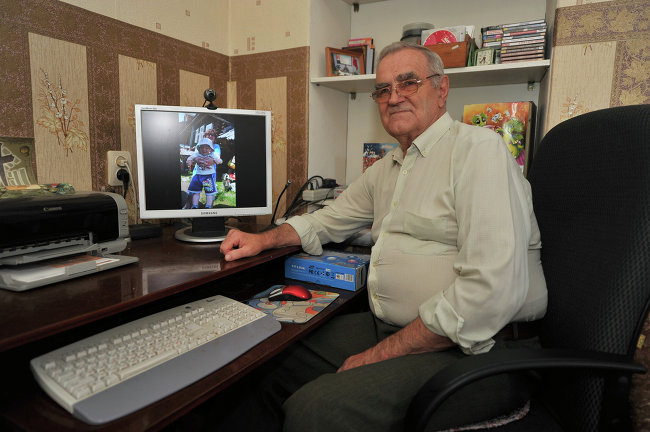
Vladimir Patokin, 2012. RIA Novosti / Sergey Kuznetsov
One of the main enemies of transplantologists is the time that must be spent searching for the desired donor and the operation itself. Thanks to the experiments of Vladimir Demikhov and further developments in the field of creating an artificial heart, today patients can wait a long time for a transplant. Today on the market there is, for example, the SynCardia Freedom Portable Driver device, a portable device that completely replaces the heart - although you have to wear it in a backpack. Such devices are still undergoing clinical trials and are not used everywhere.
When conducting operations using heart-lung machines - autojackers. The first such devices were designed in 1926 in the USSR by scientists Sergey Bryukhonenko and Sergey Chechulin . They experimented on dogs, but for the first time such a device for open heart surgery was used in 1952 in the USA. It was the heart-lung machine Dodrill-GMR, which the surgeon Forest himself Dewey Dodrill developed with General Motors. In the USSR, the first operation with artificial blood circulation was conducted by Alexander Vishnevsky in 1957.
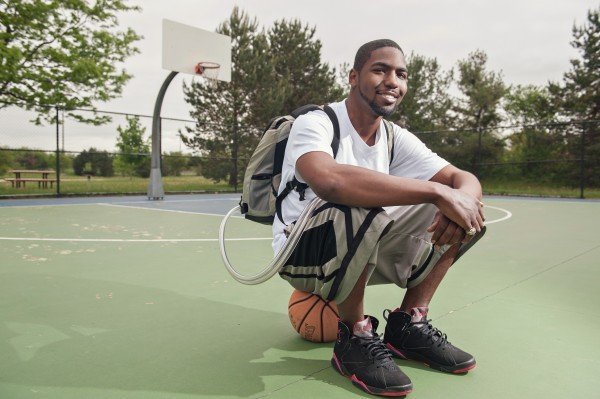
Stan Larkin, 25, passed with a pump in his backpack for 17 months
Heart transplant operations have raised new questions for the scientific community and people - religious, ethical, and legal. People mistakenly attribute emotions to the heart and often relate more positively to death than to such interference in life, to the “game of God.” In the laws of different countries, the moment of a complete arrest of a person’s heart was taken for death. For Christian Barnard, such a definition was at least strange: he was a heart surgeon and in the process of operations, in this case, he deliberately killed and then resurrected his patients. Laws, for example, did not allow taking the hearts of newborn babies without a brain that lived for no more than two days, and using them to save the lives of other newborns. In order for heart transplantation to become an almost routine operation today, changes in legislation and the introduction of donor accounting systems were required.
For half a century, patients have received the hearts of the dead thanks to advances in transplantation. In 2014, 120 heart transplants were performed in Russia, in 2016 - 200. For comparison: in the USA, 3,191 heart transplants were performed in 2016. According to the chief freelance specialist of the Ministry of Health of Russia on transplantation, director of the Scientific Center for Transplantology and Artificial Organs named after V. Shumakov Sergey Gotye, in Russia this figure should be raised to at least a thousand a year.
Fifty years of heart transplantation surgery is not considered fantastic. Let's remember how people get a second chance for life.

Surgeon monitors patient's vital signs after a 23-hour heart transplant operation
The origin of transplantology
By the beginning of the 20th century, the first successful organ transplant operations, including man, had already been carried out in the world. In 1905, in the Czech Republic, doctor Edward Cirm used the cornea in both eyes of an 11-year-old child to transplant a 45-year-old man. As a result, one eye could not be saved, and the second continued to see for 12 years until the patient died. The cornea has no blood vessels, most often survives, but in this case the most important is the issue of preserving the donor material.
This problem was solved by the Russian ophthalmologist Vladimir Filatov : he began to transplant corneas of corpses, and kept the material for the operation for 1-2 days after the death of the donor at a temperature of 2-4 degrees above zero in a humid chamber. The first successful operation of this kind took place in 1931. In addition, Filatov, together with designer A. Martsinkovsky, developed tools that were less dangerous for the lens and increased the efficiency of the operation.
"Odessa is my only lighthouse,
There are fights with a mat and without a mat,
And if you get an eye out in Odessa
Then this eye will give you Filatov. ”
Odessa lights the lights, E. Agranovich

Ophthalmologist Vladimir Filatov at work
The next important step in transplantation was kidney transplantation. In Russia, Yevgeny Chernyakhovsky experimented in this direction. In 1903-1904, this surgeon performed 554 surgeries on the abdominal organs, heart and blood vessels. Since 1907, he experimented with kidney transplantation on animals, which he told in 1913: “We succeeded in kidney transplant experiments, the vascular permeability was restored, but then the kidney gangrenisciation”. In the 1920s, he continued to experiment with his student Yuri Voronim .
In 1930, at the Third All-Union Congress of Physiologists, Yuriy Voronoi presented a dog with a kidney transplanted to its neck, which had been functioning by that time for more than six months. In 1933, Voronoi performed the world's first kidney transplant to a person from a deceased donor. Although donor and recipient blood groups did not match, the surgeon took a risk. The organ was transplanted to the thigh and it began to function. The patient lived for two days. An important discovery of Yuri Voronoi was the very possibility of using the cadaver kidney, an organ taken several hours after the death of a person. He established that such a kidney “comes to life” after transplantation and can function, as he wrote in the Italian scientific journal “Vіnerv hіrurgіsa” in 1934.
Yuriy Voronoi denied the possibility of using a kidney, an important organ, from a living person: "It is impossible to inflict deliberate disability on a healthy person, cutting out from him the organ needed for transplantation for the problematic rescue of the patient." But today, such operations are carried out, and the first successful was the second kidney transplant of a twin brother on December 23, 1954. Richard Herrick with a body that used to work in the body of his twin brother Ronald lived for nine years, married a nurse who looked after him during the Christmas holidays, and became the father of two daughters. In 1990, doctor Joseph Murray , who carried out this operation, received the Nobel Prize.
Immunobiological factors remained an important issue, organs could be rejected by recipients. In the case of the twin brothers, immunosuppression was not required, but this was an exception to the rule. In 1959, after a transplant from a post-mortem donor who was not a relative of the patient, body irradiation was used to suppress immunity - the result was 27 years of life after a kidney transplant operation.
Our immune system protects the body from foreign cells, which can be either an infection or a foreign organ. The development of immunosuppressants has opened a new era of transplantology. Patients take medications to avoid rejection. The side effect of these drugs is obvious: weakening of the immune system reduces the body's ability to resist infections.

Brothers Richard and Ronald Herrick
First heart transplants
One of the founders of transplantology is considered by the Soviet and Russian scientist Vladimir Demikhov . He conducted many experiments that influenced medical science. In 1937, a dog with a mechanical device in the form of a pump with an electric motor instead of a heart lived for two and a half hours.
Vladimir Demikhov transplanted lungs, heart, liver to dogs, proving the principal possibility of such operations. In 1946, he transplanted a second heart to the dog, and later completely replaced the heart and lungs. In 1954, he introduced a two-headed dog - transplanted his head with a neck and front paws of a puppy to an adult shepherd dog. He repeated this experiment twenty times, a record in which was the month of life of such a creature. His 1960 book, Transplant of Vital Organs in an Experiment, was the first monograph on transplantology in the world.

Vladimir Demikhov and a dog with two hearts
In the 1960s, a race began between several surgeons. American surgeon Norman Shamway from the Stanford Clinic successfully performed heart transplants for dogs, some of which lived up to one and a half years. He created a method by which heart transplantation is performed today: he did not remove the heart completely, but left the upper part of the atrium together with the large veins, which significantly reduced the time spent on the operation and its complexity. Norman waited for the opportunity to perform an operation on a man. - he needed donors.
Norman Shamway was ahead of Christian Barnard , an old friend of the University of Minnesota. Barnard used the insights of Vladimir Demikhov, Norman Shamway and Richard Lower . The surgeon studied in the United States, and in 1960 and 1963 he came to the USSR to Vladimir Demihov.
The recipient was 55-year-old Louis Vashkansky, who was admitted to the hospital in Groot-Shur, South Africa after three heart attacks. He agreed to the operation, since in any case he had a few weeks left to live. There were problems with the donor: the political regime of South Africa did not allow the use of the heart of blacks. Previously, because of this, there was a scandal involving Barnard himself - he transplanted a black citizen’s kidney to a white man. He was accused of experimenting with blacks. The same people with Louis of the Washkan race were only 20% of the population. Even less - with the right blood type. An accident on the road, in which a 25-year-old employee of the bank Deniz Darwal died, gave Washkan a chance to survive.

Louis Vashkansky and Deniz Darwal
Denise’s father agreed to the operation: “If you cannot save my daughter, you must try to save this man.”
The operation took place on December 3, 1967 and lasted about five hours. In the process, it was noted that the heart of the girl is much smaller than the heart of the recipient, but it still began to function. A few days later, Louis Vashkansky was able to get out of bed, he ate, smiled, and journalists constantly came to him. He lived for 18 days, after which he died of pneumonia, enhanced by suppression of the immune system to prevent organ rejection.
The next operation was more successful - Philip Bleiberg lived more than one and a half years. Dirk van Zyl after the operation in 1971 lived for 24 years. By December 1968, a year after the first operation, about 100 heart transplants were performed worldwide.

Cover of Life, December 1967: Christian Bernard and his patient Louis Vashkansky with the heart of 25-year-old Denise Darwal
In the USSR, the first heart transplant was performed much later, in 1987. In the USSR there were no donor centers. All twenty years after the operation in South Africa, Valery Shumakov, together with his colleagues, tried to prove that brain death is human death, and that in that case it should be a sufficient basis for organ removal to save other lives. In 1987, common sense triumphed, and the death of the brain began to be accepted for death in the USSR.
On March 12, 1987, the twenty-five-year-old Alexandra Shalkova with cardiomyopathy became the first patient in the USSR to undergo a heart transplant. The girl lived more than eight years. “I think she could live today. But Shura once did not take the prescribed pill on time to suppress the rejection reaction. She was ruined by ordinary negligence. This, unfortunately, happens. Not every human body can receive an implanted organ, ” said Valery Shumakov.

Surgeon Valery Shumakov and patient Alexandra Shalkova, examination after heart transplantation
Vladimir Patokin, who received a second heart in February 1992, became one of the most famous patients of the Institute of Transplantology and Artificial Organs named after Shumakov. At that time, Patokin was 40 years old, and in 2012 he celebrated the twentieth anniversary of the operation . He received a donor organ from a 27-year-old man. Already on the day of the operation, Vladimir Patokin was able to sit on the bed and walk on his feet. After a year and a half, he took part in Canada at the World Games of Transplants, and in 1994, he won a bronze medal in a 50 meters breaststroke at a heart transplant competition in Finland.

Vladimir Patokin, 2012. RIA Novosti / Sergey Kuznetsov
One of the main enemies of transplantologists is the time that must be spent searching for the desired donor and the operation itself. Thanks to the experiments of Vladimir Demikhov and further developments in the field of creating an artificial heart, today patients can wait a long time for a transplant. Today on the market there is, for example, the SynCardia Freedom Portable Driver device, a portable device that completely replaces the heart - although you have to wear it in a backpack. Such devices are still undergoing clinical trials and are not used everywhere.
When conducting operations using heart-lung machines - autojackers. The first such devices were designed in 1926 in the USSR by scientists Sergey Bryukhonenko and Sergey Chechulin . They experimented on dogs, but for the first time such a device for open heart surgery was used in 1952 in the USA. It was the heart-lung machine Dodrill-GMR, which the surgeon Forest himself Dewey Dodrill developed with General Motors. In the USSR, the first operation with artificial blood circulation was conducted by Alexander Vishnevsky in 1957.

Stan Larkin, 25, passed with a pump in his backpack for 17 months
Heart transplant operations have raised new questions for the scientific community and people - religious, ethical, and legal. People mistakenly attribute emotions to the heart and often relate more positively to death than to such interference in life, to the “game of God.” In the laws of different countries, the moment of a complete arrest of a person’s heart was taken for death. For Christian Barnard, such a definition was at least strange: he was a heart surgeon and in the process of operations, in this case, he deliberately killed and then resurrected his patients. Laws, for example, did not allow taking the hearts of newborn babies without a brain that lived for no more than two days, and using them to save the lives of other newborns. In order for heart transplantation to become an almost routine operation today, changes in legislation and the introduction of donor accounting systems were required.
Heart transplant today
For half a century, patients have received the hearts of the dead thanks to advances in transplantation. In 2014, 120 heart transplants were performed in Russia, in 2016 - 200. For comparison: in the USA, 3,191 heart transplants were performed in 2016. According to the chief freelance specialist of the Ministry of Health of Russia on transplantation, director of the Scientific Center for Transplantology and Artificial Organs named after V. Shumakov Sergey Gotye, in Russia this figure should be raised to at least a thousand a year.
All Articles